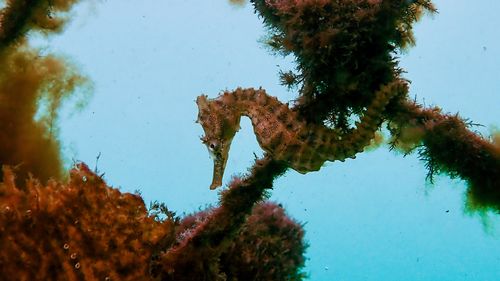Share this @internewscast.com
Measuring about 15cm from top to tail, the endangered White’s Seahorse is a unique marine creature that requires a keen eye to spot.
A 2015 study revealed that some New South Wales populations were decimated by about 90 per cent in just five years.

And the same could be happening in Queensland, but scientists would never know it.
Not only due to their small size but also because around 15 years ago, they began disappearing from Australian waters at alarming rates. Currently, there is no comprehensive research regarding the White’s Seahorse populations in the sunshine state, which means scientists do not have a baseline for comparing current population numbers.
This lack of data makes it challenging to determine if these endangered seahorses are edging closer to extinction in Queensland waters, and it hampers the potential to implement conservation strategies that might help preserve them.
University of Queensland PhD candidate Rowan Carew intends to change that.
Because if the White’s Seahorse goes extinct, Australia’s oceans will be in a dire state indeed.
“Seahorses are what we call indicator species,” Carew told 9news.com.au.

“So if we lost our seahorse species in Queensland, that would indicate that the ecosystem or environment that they’re in is unhealthy.
“And that has a trickle down effect for all sorts of animals in these ecosystems … so we definitely don’t want to lose them.”
Research has shown that habitat loss and flood events had a devastating impact on NSW populations of White’s Seahorse between 2009 and 2015.
Carew fears the same may be happening to populations in Queensland, especially after years of floods and Cyclone Alfred at the start of 2025.
“The main threat that we’re looking at potentially is habitat loss,” she said.
“Things such as weather events like the recent cyclone, things such as dredging, things such as coastal development, that all impacts their habitat.”
But their habitat also makes White’s Seahorses difficult to study in Queensland.

In New South Wales, these seahorses tend to live around swim nets and soft coral colonies, making it easy for researchers to locate them in specific areas.
Up north, they prefer to hang around in sea grass beds that can stretch for kilometers underwater, making these tiny critters much harder to find.
“It’s a little bit like looking for a needle in a haystack, which I think is why no one’s really gone to a significant effort to do any research on them in Queensland,” Carew said.
The “only reason” her team is able to attempt it now is because they have the support of the Queensland Government and millions of potential citizen scientists.

Not only will it allow them to collect additional data on individual seahorses, information sent in by citizen scientists may help them discover populations in unexpected locations.
“Our team is very small, we can’t get out into the whole of Moreton Bay and the Sunshine Coast and Gold Coast,” Carew said.
“So it’s really important to have the citizen science, because that basically informs where we’re going to do our surveys.”
There’s something in it for the citizen scientists too.
If your sighting leads the research team to a location where they find and tag a White’s Seahorse, they’ll name it after you and update you on its progress.
Carew hopes that her research will help establish key information about White’s Seahorse populations in Queensland and facilitate conservation efforts that could help get them taken off the endangered list.

Breed and release programs and installing artificial habitats have already boosted numbers in NSW, which is a promising start.
“That’s the main reason for this research and trying to push for conservation in Queensland,” Carew said.
“Because we just don’t have any of those kind of measures in place to keep numbers stable if something does go wrong.”











